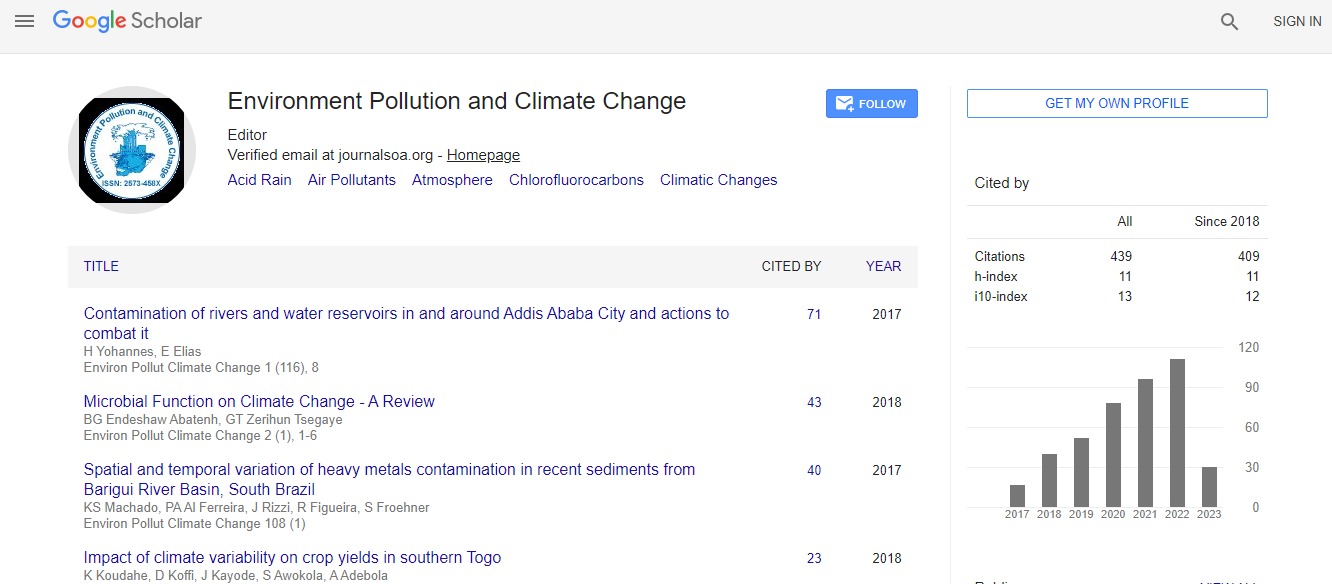Our Group organises 3000+ Global Conferenceseries Events every year across USA, Europe & Asia with support from 1000 more scientific Societies and Publishes 700+ Open Access Journals which contains over 50000 eminent personalities, reputed scientists as editorial board members.
Open Access Journals gaining more Readers and Citations
700 Journals and 15,000,000 Readers Each Journal is getting 25,000+ Readers
Google Scholar citation report
Citations : 431
Environment Pollution and Climate Change received 431 citations as per Google Scholar report
Environment Pollution and Climate Change peer review process verified at publons
Indexed In
- Google Scholar
- Publons
- Euro Pub
- ICMJE
Useful Links
Recommended Journals
Share This Page
Modelling mutational signatures of environmental carcinogens in cultured human cells
Joint Event on 5th World Conference on Climate Change & 16th Annual Meeting on Environmental Toxicology and Biological Systems
Volker M Arlt
Kings College London, UK
Keynote: Environ Pollut Climate Change
Abstract
Whole genome sequencing (WGS) of human tumors has revealed distinct patterns of mutation that hint at the causative origins of cancer. The Catalogue of Somatic Mutations in Cancer (COSMIC) is a global resource for information on somatic mutations in human cancer and currently lists 30 distinct mutational signatures. Some signatures are correlated with known environmental exposures, but the causative origins of many signatures remain unknown. We have developed an experimental approach using human induced pluripotent stem (iPS) cells to define mutational signatures of environmental carcinogens by WGS. Treatment conditions (e.g. concentration) for WGS were optimized by assessing cytotoxicity, DNA damage response signaling and the formation of premutagenic DNA adducts. After WGS, a ubiquitous background mutational signature was extracted in all clones showing similarities with COSMIC Signature 18 which has been reported in other cultured human cells. Specific signatures were identified in human iPS cells, following exposure to benzo[a]pyrene (BaP), simulated sunlight aristolochic acid I (AAI) and aflatoxin B1 (AFB1), revealing characteristic mutation pattern for each carcinogen that were highly similar to COSMIC signatures of mutations found in tumors of individuals who were exposed to the agent of interest: predominantly G to T mutations for BaP were linked to COSMIC Signature 4; C to T for simulated sunlight was linked to COSMIC Signature 7; A to T for AAI was linked to COSMIC Signature 22; and G to T for AFB1 was linked to COSMIC Signature 24. Thus, human cell-based systems and WGS can be used to study the genome as a record of environmental exposure. Recent Publications 1. Long A S, Wills J W, Krolak D, Guo M, Dertinger S D, et al. (2018) Benchmark dose analyses of multiple genetic toxicity endpoints permit robust, cross-tissue comparisons of MutaMouse responses to orally delivered benzo[a]pyrene. Arch. Toxicol. 92(2):967–982. 2. White P A, Douglas G R, Phillips D H and Arlt V M (2017) Quantitative relationships between lacZ mutant frequency and DNA adduct frequency in Muta™Mouse tissues and cultured cells exposed to 3-nitrobenzanthrone. Mutagenesis 32(2):299– 312. 3. Kucab J E, Zwart E P, van Steeg H, Luijten M, Schmeiser H H, et al. (2016) TP53 and lacZ mutagenesis induced by 3-nitrobenzanthrone in Xpa-deficient human TP53 knock-in mouse embryo fibroblasts. DNA Repair 39:21–33. 4. Nik-Zainal S, Kucab J E, Morganella S, Glodzik D, Alexandrov L B, et al. (2015) The genome as a record of environmental exposure. Mutagenesis 30(6):763–70. 5. Kucab J E, van Steeg H, Luijten M, Schmeiser H H, White PA, et al. (2015) TP53 mutations induced by BPDE in Xpa-WT and Xpa-Null human TP53 knock-in (Hupki) mouse embryo fibroblasts. Mutat. Res. 773:48–62.Biography
Volker M Arlt has an international profile of research in Environmental Carcinogenesis and Toxicology evidenced by over 180 articles published in high-ranked international journals within the field of research. His expertise is firmly rooted in Molecular Carcinogenesis as well as Genetic and Environmental Toxicology. He is Senior Lecturer in Environmental and Genetic Toxicology at King’s College London and based at the Department of Analytical, Environmental and Forensic Sciences within the School of Population Health & Environmental Sciences. He also belongs to the MRC-PHE Centre for Environmental & Health. He is a European Registered Toxicologist.
E-mail: volker.arlt@kcl.ac.uk

 Spanish
Spanish  Chinese
Chinese  Russian
Russian  German
German  French
French  Japanese
Japanese  Portuguese
Portuguese  Hindi
Hindi 
